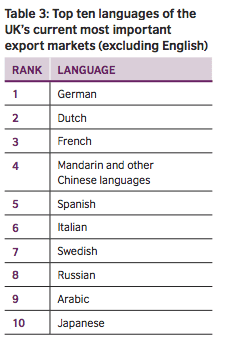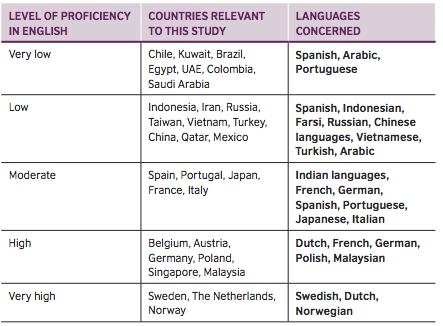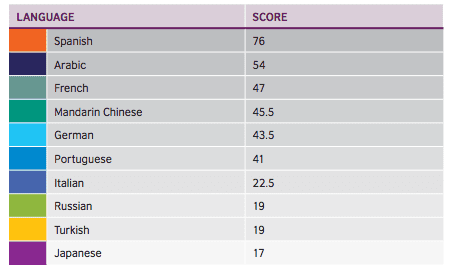To Localize or not to Localize, That Is the Question…

It’s no secret that to be successful globally, your product has to speak English, and speak it well. Whether it’s a humble piece of software, an app, a book, movie or a game – you have to make sure it reaches the global audience. But reaching the global consumer nowadays is no longer a guarantee that the product will be accepted and embraced, just that it will be understood. The global village speaks many tongues, and surprisingly, their importance has never been greater or more obvious than in the predominantly English-speaking Internet age. Enter localization; the solution to connecting global consumer to a local product. But what places – or, rather, cultures – should you attempt to reach in the first place? Read on to find out…

So what is localization, exactly? Sometimes referred to as „l10n” to save space (it’s „L” followed by 10 letters, then „n”, so – l10n), it’s a way of making your product not just translated, but adapted to another culture via making its content more viable in a new context. You’re not only putting words that were written into another language, you put thoughts that were behind these words into that new pattern of thinking as well – and then follow the words from there.
Where you would translate a book, including its prose or verse, into something that combines form and content as closely as possible, with localization practices you want your product to speak to a person in another country or culture. Thus, „Winnie the Pooh” was translated into something entirely different around the world (consider Polish „Kubuś Puchatek”, which has neither „Winnie” nor „Pooh” in the name!), and managed to achieve cult status even in places where the humble bear of little brain would otherwise be an unwelcome guest. While common translation of Shakespeare is still a translation, even though an incredibly advanced one, considering you have to transmit not just what is said, but how it’s said, what rhythm it has, how it rhymes etc., the 1996 hit Romeo+Juliet is an actual cultural adaptation of Shakespeare’s original play, where new culture to which it was adapted was simply four centuries removed from the original… And on another side of Atlantic. Powerful stuff, that: localized (linguistically adapted to the culture) products are proven to be vastly more popular in their target cultures than their predictable one-size-fits-all English translations.

Some products, like games, are nearly impossible to sell well in local markets without full localization, as many titles to date have shown. Other multimedia, like films or video clips, benefit most from the emotional and personal connections that are forged between the viewer and the movie. Don’t know what we’re talking about? Well, consider Garfield, whose love for lasagna had become love of Kugelis in Lithuania, where this local potato dish is way more popular. Or think about Ski Safari, a game that was originally only reaching 35000 customers in its homeland and that garnered a following of over 70 million when localized to China! The figures are impressive indeed.
But here’s the question that any entrepreneur with a product would ask first and foremost: sure, localization sounds fine and dandy, but is my product suited for it? And if it is, where should I market to? I mean, it’s not like there’re just five or six languages around the world… Or are there?
Population: the native speakers?
Classic approach to translation of any product – software or „real” – begins with identifying the maximum target group for any given language and then attempting to reach them all via translations. Localization is no different, though perhaps it takes a little more into account when picking a culture to localize to.
There’s a lot of stats out there that give preference to one culture or another, but classic approach is all about selecting languages with largest volume of native speakers. In theory, it should help you aim your translated product at a bigger target, but in reality, it’s still a game of hit-and-miss.
Take a look at some data that should paint a clearer picture:
- China leads with Mandarin Chinese, whose speakers number in 848 million,
- Spanish speakers in Europe and Latin America come in strong with 406 million,
- Despite being bearers of the global standard, there’re just 335 million English native speakers,
- Hindi is spoken natively by about 260 million people,
- All variants of Arabic put together are learned from birth by 223 million people,
- 203 million people speak Portuguese (this includes Brazilian),
- Bengali is spoken by 193 million people natively,
- There’s only 162 million native speakers of Russian,
- Even fewer – 122 million people – speak Japanese,
- Just 84 million people speak native Javanese, rounding off the list of the global native speaker powerhouses.
Surprising? It should be, because while the number of native speakers is informative to some extent, it’s NOT what seasoned localization specialists use when advising on culture choices for localization.

Luckily, some bright spark at marketing thought: what if we think about our product… like a product? So, then, who buys most of our country’s product, thus showing clear demand? Who will possibly appreciate being spoken to in their own language? That’s how targeting by exports was born. It’s quite simply when you go to where the people buy most, and translate to that culture, hoping to build brand loyalty through engagement and that enigmatic (and mostly meaningless) term – synergy.
For the UK, that list is as follows:
- Germany
- Holland
- France
- China
- Spain and Lat.Am.
- Italy
- Sweden
- Russia
- Arabic countries
- Japan
This would mean that theoretically, Germany is your preferred target market, so at the barest minimum, an effort should be made to adapt your content to German-speaking populace in the so-called DACH countries (which comprise Germany, Austria and Switzerland). But that is clearly still not enough to open new markets. And just saturating an existing marketplace will dilute your revenue.
Who DOESN’T speak English?
What to do, then? Well, fear not, for the agile-thinking, lean-six-sigma black-belted pro entrepreneur has you covered. Approach it from a „business pain” perspective, think like a manager, he says!
A business pain is what someone’s business desperately needs, and you as a possible partner „alleviate” that pain by providing your service, product… You name it. So, let’s identify pain of some countries vis-à-vis localization. How about… They speak bad English, so they will not be able to say no to a product that is translated to their language – no matter the quality?! Sounds good? Yep. So, why bother localizing, if you can find countries where English is perhaps not the most common language, and go from there, perhaps even machine-translating as you go? Surely, that will cut costs and improve our bottom line! But… It soon appears that it’s far from a panacea. Your headache will still be there, and raging, once you find out that bitter pill is really hard to swallow. Here, take a look at the list of those product-hungry customers that will not be able to resist your poorly translated charms:


Localize everything!
So now that you know WHO will be buying your product, you should really make sure… Is this product worthy of a full-on localization? Because yes, nearly any product _can_ be localized, even a loaf of bread may be culturally adapted. But _should_ any product be localized, considering huge cash investments that entails? No goods were created equal! Typically, your product with little or no language content may not require extensive translations, much less cultural adaptation. On the other hand, products that are nearly all language will require thoughtful adaptation, but it will COST a lot. In essence, every product will gain something from being available to a greater demographic, but not all will give you proper ROI.
Some types of content are simply better suited for full localization and earn substantially larger profits when adapted outside of their country of origin. These are mostly media products like film, online presences like social media and websites and, finally, software, apps and games. But even though these are all great candidates for localization, each one requires a slightly different approach; let’s have a brief look, shall we?

There’s no hard and fast rule regarding the depth of localization for multimedia content, especially classic ones: TV and movies. There’re several good practices, though.
But first things first: what are subs, and what are dubs? Subs- or subtitles – are simply written words, translated or localized from the source into target culture and displayed at the bottom of the screen in synchronization with their spoken equivalent. Dubs – in this case, dubbing – involve replacing what is heard in the source movie or media with recordings of actual audio for each (or most) characters in the culture language, spoken (and recorded) by professional native speakers of that language. With some magic of audio editing, the original voices only are silenced, leaving every other sound intact. Of course, subtitles are much cheaper to make than dubbing, hence it’s a huge question of what to choose.
Another important issue to consider is the size of the country you’re targeting. In essence, the existing market has already created expectations regarding localization, and so you’re bound by the history, and that is inevitably tied to the country’s size, of all things.
As it happens, countries around or below 10 million people are used to subtitles nearly exclusively, because smaller countries that are developed enough to have a robust market for TV and media have too small speaker base to be „worth it”, so to speak. But it’s more than just number, as
- these countries are usually multilingual by default. States like Holland, Luxembourg, Denmark, Belgium, Greece, Finland and Sweden, where English is either nearly universal or there’s more than one language spoken, often have more than one national tongue. Tailoring your product to just one culture may offend the other one.
- some types of dubbing are more preferred in certain countries to others. In countries like Italy one actor may be voiced by the same voice actor in every movie, creating a sort of continuity for the viewer. In others, so-called „whisper dubbing” is more common, wherein a single „lector” speaks every line with a slight delay compared to the original, regardless of gender, age or status of every actor involved in the original.
Websites: UX and UI?
Website localization is a relatively new idea, as so far, most sites had been able to pass for reasonably well-crafted even if MT (machine translation) has been used. Nowadays, websites are not just created to deliver information, they’re centred around the concept of „UX” – user experience. Broadly speaking, it’s an idea that to navigate anything – a website, a game, a piece of software, an app, even a car’s built-in DVD player – creator of that medium has to think like a customer or user, not like an engineer or programmer. The idea is to make buttons easy to press, features easy to turn on, make moving around menus or subsections with ease, and to generally have a good experience (hence UX) dealing with the system, program, website etc.

To make the site’s UX a breeze, you will have to localize the content. Thus, a simple instruction in English will become something a little different. But even an innovative concept like UX is not mentioned alone in most contexts – usually it’s bundled with UI, or User Interface. This s simply the buttons, menus, layout of help elements and navigation… Simply? No, not really. Not when languages that read right to left (Arabic) or back to front (Japanese) are concerned – then your UX is directly tied to UI, and vice versa. That’s why the two often go hand in hand, and the way localization approaches the problems of adapting dynamic content such as websites.
Finally, best website localizations don’t neglect embedded language content – be it videos or pictures that contain or feature words. It’s considered one of the best practices around to localize them as well. This is usually referred to as „transcreation”, as you not just translate, but remake an image or video, changing any instances where some word or words are shown, heard or alluded to. Localization teams that adapted Evernote know a thing or two about that. From giants like AirBnB to more modest start-ups Erica Perrot’s site, it’s now the industry standard well worth adopting.
Apps and Games: the platform?
Even a few years ago, fun games were already serious business, but nowadays, it’s the biggest entertainment industry worldwide. It’s worth more than film and music industries combined, and that’s saying something. But what of selling games?

But this is an age of scale, and the economy of scale, so many companies instead focus on mobile market, which is very, very lucrative for local recipients in particular. Apple iOS’s iTunes is traditionally viewed as a great way of making money off of the never-ending boom for iPhones and related apps, games included. Some show that English is still dominant here, but Chinese is rapidly gaining ground.
While more than a million apps are in English on iTunes, nearly 200 thousand are now (also) in Chinese. Top ten languages for apps here include:
- English (incl. UK, Aus and Can)
- Chinese
- German
- Japanese
- French (incl. all varieties)
- Italian
- Russian
- Portuguese (incl. Brazilian)
- Korean

But things look a little different once you also include Android (and Google Play) into the mix. Suddenly, other countries pop to the top, with Asia as the leading region. Bear in mind that in 2014, China became 2nd global gaming market by size, revenue and growth combined. Thus, the top-10 for mobile apps and games for both iOS and Android is best represented by the following tongues:
- English
- Japanese
- Korean
- Chinese
- German
- French
- Brazilian Portuguese
- Spanish
- Italian
- Malay
If you’re wondering about the last one, it’s there to represent the SE Asian mobile kings: Indonesia, Malaysia, Singapore, Vietnam, Philippines and Thailand, countries where Malay is dominant as first or second spoken language.
So… Think you’re ready to take the plunge and localize? Don’t worry… You can start slow. Shall we say, 100 000 words in 20 languages, for starters? 
VOCABULARY
humble – skromny, prosty
audience – odbiorcy, czytelnicy
to embrace sth – zaakceptować coś, przyjąć
tongue – język
predominantly – głównie, w przeważającej mierze
enter X – i oto X, nadchodzi X
to refer to sth as sth – określać coś mianem czegoś
to follow sth – nastąpić po czymś
via – za pośrednictwem
viable – tu: mający sens, istotny
pattern – wzorzec
verse – wiersz, poezja
to combine sth and sth – połączyć coś z czymś
to consider sth – zastanowić się nad czymś, pomyśleć o czymś
cult – kultowy
otherwise – w innym przypadku, inaczej
an unwelcome guest – niechciany gość
considering… – zważywszy, że…/na…
removed from sth – oddalony od czegoś
stuff – rzecz, coś
vastly – ogromnie, bardzo
predictable – przewidywalny, dający się przewidzieć
one-size-fits-all – na jedno kopyto, w uniwersalnym rozmiarze
to date – na chwilę obecną
to benefit from sth – skorzystać na czymś
to forge sth – ukuć coś, utworzyć
way – tu: o wiele, o wiele bardziej
homeland – ojczyzna
to garner sth – zebrać coś, zdobyć
following – tu: zwolennicy, fani
figures – liczby
impressive – imponujący
entrepreneur – przedsiębiorca
first and foremost – przede wszystkim
sth sounds fine and dandy, but… – brzmi to fajnie, ale…, wszystko (to) ładnie-pieknie, ale…
suited for sth – pasujący do czegoś, odpowiedni
to take sth into account – brać coś pod uwagę
to pick sth – wybrać coś
stats – dane, statystyki
to give preference to sth – preferować coś, optować za czymś
volume – objętość, ulość
hit-and-miss – bezplanowy, na chybił trafił
to paint a picture – zarysować sytuację, opisać stan/sytuację
to number in X – liczyć sobie X
to come in strong with X – zdobywać solidny X (np. o ilości punktów lub wygranych)
bearer – nosiciel
to put sth together – zsumować coś
to round sth off – zakończyć coś (listę)
powerhouse – potęga (np. gospodarcza)
to some extent – do pewnego stopnia
seasoned – doświadczony, zaprawiony w boju
some bright spark – ktoś utalentowany, jakiś mądraliński
demand – popyt, zapotrzebowanie
engagement – zaangażowanie
term – pojęcie
synergy – synergia
bare minimum – absolutne minimum
to make an effort – wysilić się, postarać
populace – ludność
so-called – tak zwany (tylko rzed rzeczownikiem)
to comprise sth – składać się z czegoś
to saturate sth – wysycić coś
to dilute sth – rozrzedzić coś, zmniejszyć intensywność/wielkość czegoś
revenue – przychody, wpływy
agile – gibki, zwinny
lean – smukły
pro – profesjonalista
to have someone covered – mieć odpowiedź na czyjś problem
to alleviate sth – załagodzić coś, zmniejszyć (ból)
to provide – zapewnić, dać
vis-à-vis X – w zakresie, jeśli chodzi o X
why bother… – po co się starać…, po co się wysilać
to machine-translate sth – przetłumaczyć coś automatycznie/maszynowo
to cut costs – obciąć koszta
to improve – polepszyć, poprawić
bottom line – rachunek zysków i strat
panacea – panaceum, lek na wszystko
raging – rozszalały, wściekły
a bitter pill to swallow – gorzka pigułka do przełknięcia
to resist sb’s charms – oprzeć się czyimś powabom/powabowi
an exercise in futility – marne starania, próżny wysiłek
sth is far from X – coś nie jest ani trochę X
research – badanie, badania
to carry sth out – przeprowadzić coś
ultimately – ostatecznie
worthy of sth – wart czegoś, godzien
full-on – kompletny, pełny (pot.)
to entail sth – pociągać coś za sobą
sth wasn’t created equal – coś nie jest sobie równe
extensive – rozległy, szeroki
in essence – faktycznie, w istocie rzeczy
ROI (return on investment) – zwrot z inwestycji
substantially – pokaźnie, znacznie
country of origin – kraj pochodzenia
slightly – nieco
brief – krótki
subs (subtitles) – napisy (do filmu)
dub (dubbing) – dubbing, udźwiękowienie wersji językowej filmu
hard and fast rule – ściśle określona reguła
regarding sth – odnośnie (do) czegoś, co się tyczy czegoś
depth – głębia
bottom – dół
synchronization – synchronizacja, zsynchronizowanie
character – postać
to silence sth – wyciszyć coś
intact – niezmienny, bez zmian
hence – zatem, stąd
expectations – oczekiwania
bound by sth – związany czymś, zobowiązany przez coś
inevitably – nieuchronnie
X, of all things! – i to właśnie X!, co dziwniejsze, to X!
exclusively – wyłącznie
robust – silny, zdrowy
to tailor sth to sth – dostosować coś do czegoś
to offend sb – obrazić kogoś, urazić
continuity – ciągłość
wherein – w którym
delay – opóźnienie
compared to sth – w porównaniu do czegoś
regardless of – niezależnie od
relatively – stosunkowo
to pass for sth – wyglądać na jakiegoś na pierwszy rzut oka
reasonably – dość, całkiem
well-crafted – dobrze zrobiony
broadly – szeroko
built-in – wbudowany
feature – funkcja
ease – łatwość
to deal with sth – zajmować sie czymś
readable – czytelny
consideration – wzgląd, okoliczność
to browse sth – przeglądać coś, tu: przejść gdzieś/do czegoś
depending on – w zależności od
standing – status
concept – idea
to bundle sth with sth – połączyć coś z czymś, stworzyć pakiet/kombinację czegoś i czegoś (np. przy sprzedaży, opisując coś itp.)
layout – układ graficzny, szata
to go hand in hand – iść ręka w rękę
embedded – zagłębiony, osadzony
to contain – zawierać
to remake – ponownie stworzyć
instance – przypadek
to allude to sth – nawiązywać do czegoś
mere – ledwie, tylko
release – wypuszczenie (na rynek)
to lead the pack – być liderem, przodować
economy of scale – gospodarka skali masowej
to view sth as sth – postrzegać coś jako coś
to make money off of sb – zarabiać na kimś
rapidly – szybko
to gain ground – nadrabiać straty, doganiać
no doubt – bez wątpienia, z pewnością
to even out – wyrównywać się, wypoziomować
to drive the growth – napędzać wzrost
eerily – niesamowicie
to bear sth in mind – pamiętać o czymś, mieć coś na względzie
to take the plunge – dać nura, zdecydować się na stanowczy krok
by Prochor Aniszczuk







